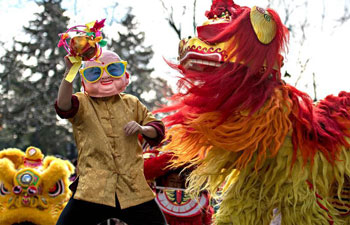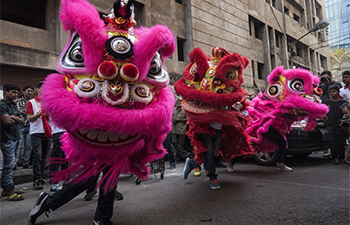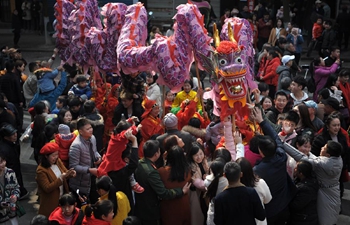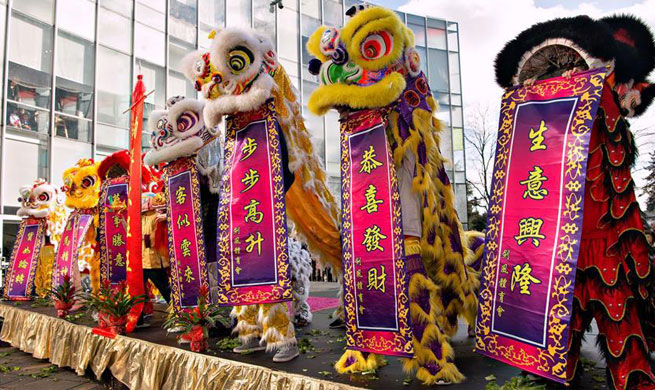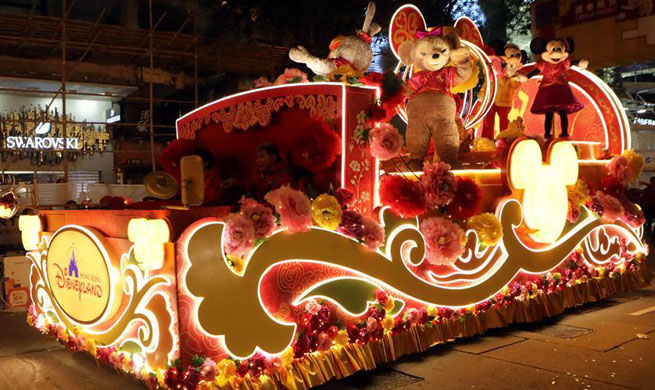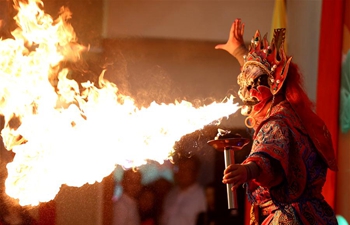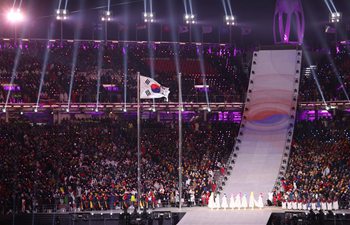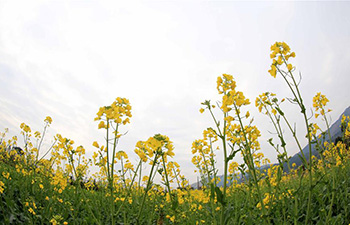LANZHOU, Feb. 17 (Xinhua) -- The Zhongshan Bridge in Lanzhou of northwest China's Gansu Province always reminds Ma Ting of his grandparents.
His grandparents used to live by the Yellow River. "Every time I visited my grandpa, the bus I took went over the iron bridge," said Ma, 40. His grandfather, who was running a beef noodles restaurant at that time, "would cross the Yellow River bridge everyday by bike".
A PERMANENT BRIDGE
Zhongshan bridge, built in 1906, was among the oldest permanent bridges built over the Yellow River, known as China's mother river.
Crossing the Yellow River had been a challenge as it is fast flowing and treacherous. A folk song compared crossing the river with "passing through the gates of hell."
In winter, when the river iced over, people used to tie a bamboo pole across their waist and edge across the surface. If the ice broke, they would not be washed away. In more clement weather, rafts or floating bridges made the journey less perilous.
"Floating bridges were set up and dismantled each year. Sometimes they were damaged by floods," said scholar Deng Ming, who has spent more than 30 years studying the history of Lanzhou.
Zhang Debao, who once worked on sheepskin rafts, well understands the danger of his job.
"The Yellow River is turbulent, and the raft could be turned over at any minute. Doing this work, our lives were always on the line," he said.
Local officials during late Qing Dynasty (1644-1911) had long-considered building a permanent bridge, and in 1906, Sheng Yun, then governor of Shaanxi and Gansu, gave the go ahead. The project was contracted to a German firm, Telge and Schroeter.
"Sheng once worked as foreign minister and was open-minded," Deng said. "The project was a pioneering act of international cooperation in China."
"All the materials were imported from Germany, from the steel structure down to the paint and screws," he continued.
They were delivered to Lanzhou by ship, train, horse carriage, mules and camels. The journey took 23 months. Consignment alone accounted for 40 percent of the total cost. The bridge was completed in 1909.
"It was painted orange so as to appear more Chinese," Deng said."During World War II, it played an important role in transportation and was painted gray so as to avoid bombing by the Japanese invaders."
In 1928 people named it Zhongshan Bridge in memory of revolutionary leader Sun Yat-sen. In 1954, the bridge underwent an overhaul.
"They were so many workers," Deng said. "Many parents took their children to watch the project."
GOING THROUGH THE BRIDGE
For more than a century, many living near the bridge went through various changes, including those of Zhang Debao and Ma Ting.
Ma's great grandfather began cooking beef noodles early last century, and in the 1950s his grandfather, Ma Zilu, founded a beef-noodle brand with his own name.
"My grandpa devised the soup recipe, which was kept secret and only passed down within the family," he said.
Ma had no foreign apprentice until he met Seino Takeru from Japan.
Seino Takeru, 38, studied in Beijing in the late 1990s, and developed the habit of eating beef noodles. After he returned to Japan, he missed the noodles so much that he visited Lanzhou in 2015.
"I tried several restaurants and found that Ma Zilu was the best," he said. "Walking on the iron bridge, I made my mind to bring the beef noodles to Japan."
Ma Ting turned him down. But Seino Takeru did not give up.
"He visited me three times," said Ma Ting, "His sincerity and persistence moved us. We decided to make him our apprentice. After all, it is not bad to have Lanzhou beef noodles go abroad."
He taught Seino Takeru how to make hand-pulled noodles but still kept the soup recipe as a secret as his father had told him to.
In August 2017, Seino Takeru opened a Ma Zilu franchise in Tokyo. The soup powder was delivered by Ma Ting from Lanzhou at his request.
The restaurant proved a success locally. "The prices of noodles are slightly higher compared with others," Ma Ting said. He visited the restaurant in November, and queued for 40 minutes to eat the noodles, which, he said, taste similar to what he has at home.
THE INVISIBLE BRIDGE
Liu Li, a 38-year-old flight attendant with China Eastern Airlines, has also felt many changes over the years.
"I grew up by the iron bridge, where there were many visitors. But I seldom saw foreigners when I was young," she recalled. "Once I saw one, I would follow him or her curiously."
She began working as flight attendant in 2005.
"At first the foreign passengers we had were mostly tourists from Japan," she said. "We saw a boom of American and European passengers after 2010, as more performance troupes came in."
China Eastern Airlines opened its first international flight route in Lanzhou in 2013, which was to Singapore. In 2014, for the first time Liu served on an international flight, to New York.
"Chinese products are common in foreign countries, where many things are 'made in China,'"she said. "In Western supermarkets I can even find rice from Wuchang county in northeast China. Our country is becoming increasingly prosperous."
On Nov. 2, Michael Clauss, the German ambassador to China, visited the Zhongshan Bridge. He said the bridge was a sign of China's opening up to the rest of the world.
Now a new bridge has been set up between China and Germany - the Belt and Road Initiative. "Germany has welcomed and supported the Belt and Road Initiative from the beginning," Clauss said. "China has become our important trade partner in the world."
The Belt and Road Initiative, which aims to build infrastructure and trade networks to connect countries in Asia, Africa and Europe along ancient Silk Road trade routes, has gained support from more than 100countries and international organizations worldwide.
Zhang Debao's sheepskin rafts are no longer used for transport. He now serves tourists from around the world.
"Now that we have better roads and more bridges, we still should preserve the sheepskin rafts as part of our cultural heritage and hand it down through the generations," he said.
The iron bridge should also be preserved. In many ways it is a symbol of China's development and opening up to the outside world, and how the country is always reaching out to other cultures. So much of China's rise has been about building bridges, both real and metaphorical.
"The bridge played different roles in different periods of history," said Deng Ming. "Now people could still see the pioneering spirit it showed more than 100 years ago, which is always necessary in development." Enditem





